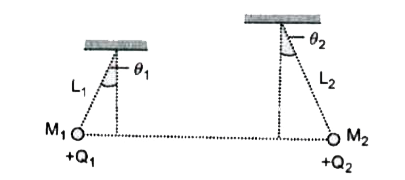An electron and a photon possess the same de-Broglie wavelength. If Ee and Eph are respectively the energies of electron and photon and v and c are their respective velocities, then EeEph=Solution in Kannada
vc
v2c
v3c
v4c
The correct Answer is:B
λ=h√2mEe
Also λ=hcEp,ButEe=12mv2
So m=2Eev2
⇒2Eem=m2v2=(m2v2)=(mv)2=p2[∴P=(Epc)]
∴e[2Eev2]Ee=E2pc2
Solving EeEp=v2c
Topper's Solved these Questions
- ELECTRONS & PHOTONSBOOK - MODERN PUBLICATIONCHAPTER - ELECTRONS & PHOTONSEXERCISE - MULTIPLE CHOICE QUESTIONS (LEVEL-II)
63 Videos
- ELECTRONS & PHOTONSBOOK - MODERN PUBLICATIONCHAPTER - ELECTRONS & PHOTONSEXERCISE - MULTIPLE CHOICE QUESTIONS (LEVEL-III)
9 Videos
- ELECTROMAGNETIC WAVESBOOK - MODERN PUBLICATIONCHAPTER - ELECTROMAGNETIC WAVESEXERCISE - RECENT COMPETITIVE QUESTIONS
4 Videos
- ELECTROSTATICSBOOK - MODERN PUBLICATIONCHAPTER - ELECTROSTATICSEXERCISE - RECENT COMPETITIVE QUESTIONS
39 Videos
Similar Questions
Maximum frequency of the photon produced by the union of a proton and a antiproton is (given : mp=1.67×10−27kg):
View SolutionEnergy required for the electron excitation in Li++ from the first to the third Bohr orbit is :
View SolutionThe speed of electromagnetic wave in vacuum depends upon the source of radiation
View SolutionTwo small spheres of masses M1andM2 are suspended by weightless insulating threads of lengths L1andL2 The spheres carry charges Q1andq2 respectively . The spheres are suspended such that they are in level with one another and the threads are inclined to the vertical at angles of θ1andθ2 as shown . Which one o fthe following conditions , if θ1=θ2 ?

View SolutionAn electron and a photon possess the same de Broglie wavelength. If Ee and Eph are, respectively, the energies of electron and photon while v and c are their respective velocities, then EeEph is equal to
View SolutionIn Q.72, if the velocity of electron is 25% of the velocity of photon, then (E_e)/(E_(ph)) equals
View SolutionA photon has same wavelength as the de Broglie wavelength of electrons. Given C=speed of light , v= speed of electron. Which of the followitg relation is correct? [Here E_e= kinetic energy of electron, E_(ph)= energy of photon, P_e= momentum of electron and P_(ph)= momentum of photon]
View SolutionIf E1,E2,E3,E4 are the respective kinetic energies of electron, deutron, proton and neutron having same de-Broglie wavelength. Select the correct order in which those values would increases.
View SolutionIf E1,E2andE3 represent respectively the kinetic energies of an electron , an alpha particle and a proton each having same de Broglie wavelength then :
View SolutionA photon and an electron posses same de-Broglie wavelength. Given that c= speed of light and v=speed of electron, which of the following relations is correct? Here Ee=KE of elecron, Eph=KE of photon, pe=momentumofe≤ctron,p_(ph) = momentum of photon:
View SolutionAn electron with speed v and a photon with speed c have the same de-Broglic wavelength. If the kinetic energy and momentum of electron is E_(e) and P_(e) and that of photon is E_(ph) and P_(ph) respectively, then correct statement is -
View SolutionIf E1,E2andE3 represent respectively the kinetic energies of an electron , an alpha particle and a proton each having same de Broglie wavelength then :
View SolutionThe wavelength of a photon and de - Broglie wavelength an electron have the same value. Given that v is the speed of electron and c is the velocity of light. Ee,Ep is the kinetic energy of electron and energy of photon respectively while pe,ph is the momentum of electron and photon respectively. Then which of the following relation is correct?
View Solutionif the velocity of electron is 25% of the velocity of photon, then EeEph:
View Solutionएक फोटॉन तथा एक इलेक्ट्रॉन समान दे-ब्रोग्ली तरंगदैर्ध्य रखते है। दिशा गया है कि इलेक्ट्रॉन का वेग v तथा प्रकाश का वेग c है। Ee,Ep इलेक्ट्रॉन तथा फोटॉन कि क्रमशः गतिज ऊर्जा है। pe,ph इलेक्ट्रॉन तथा फोटॉन के क्रमशः संवेग है, तब सही सम्बन्ध है
View Solution
